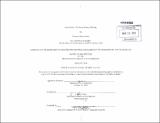Even slower : the great smog of Beijing
Author(s)
Hendranata, Erioseto
DownloadFull printable version (38.21Mb)
Alternative title
Great smog of Beijing
Other Contributors
Massachusetts Institute of Technology. Department of Architecture.
Advisor
J. Meejin Yoon.
Terms of use
Metadata
Show full item recordAbstract
Since the global media exposure of its air quality in 2008, Beijing has strived to improve its air quality. However, these preventive measures have not extensively altered the intensity of the smog-filled sky. This phenomena have generated an opportunity to redefine the position of architecture within the context of slow catastrophe in the form of the corrupted air particles. Instead of appearing to be physically and mentally defective, this threat occurs in the form of environment, which is invisible and can only be experienced unconsciously. With the current average of 660,000 people dying in China, and approximately $17,000,000 spent annually on cleaning up its air, Beijing cannot afford to rely on its soft health policies and its air tax anymore. In its current destructive rate, the particles will force the government to, eventually, undertake physical interventions at urban scale, i.e. provisions of a series of air shelters as nodes of refuge that have to provide both protection and recovery of the citizen's health. This thesis will, therefore, serve as a platform for questioning and investigating the relationship between architecture and the polluted environments through the discussions of the historical, theoretical, and political aspects of air. Looking at human as its subject, this thesis looks into the survival scenarios that Beijing government will implement as its civilian air defense strategy. One hypothesis can be taken that these interventions will also be coupled with the existing network of Beijing's underground network, including the subway stations, to mutually serve as defensive urban infrastructure. In the end, what these territorial air remedy strategies might suggest is the role of architecture as an agent in producing environment where the human limit is slowly altered in the process of slowing down the consequences of a slow catastrophe.
Description
Thesis: M. Arch., Massachusetts Institute of Technology, Department of Architecture, 2014. Cataloged from PDF version of thesis. Includes bibliographical references (page 137).
Date issued
2014Department
Massachusetts Institute of Technology. Department of ArchitecturePublisher
Massachusetts Institute of Technology
Keywords
Architecture.